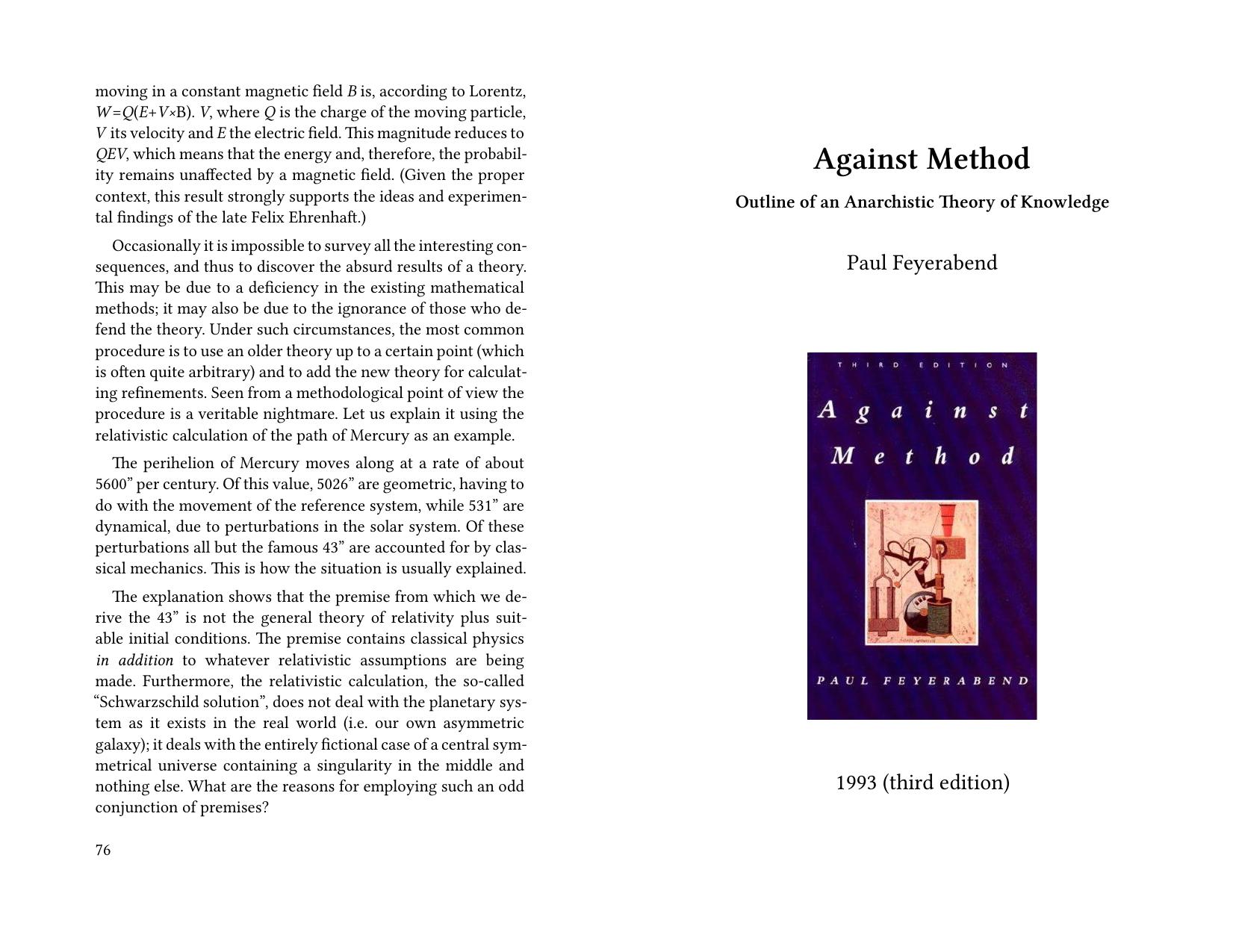Against Method by Paul Feyerabend

Author:Paul Feyerabend
Language: eng
Format: epub, mobi, pdf
Tags: epistemology, science
Published: 1993-02-20T16:00:00+00:00
14
Galileo’s inquiries formed only a small part of the so-called Copernican Revolution. Adding the remaining elements makes it still more difficult to reconcile the development with familiar principles of theory evaluation.
Galileo was not the only scientist involved in the reform of physics, astronomy and cosmology. Neither did he deal with the whole area of astronomy. For example, he never studied the motion of the planets in as much detail as did Copernicus and Kepler and he probably never read the more technical parts of Copernicus' great work. That was not unusual. Then as now knowledge was subdivided into specialities; an expert in one field rarely was also an expert in another and distant field. And then as now scientists with widely diverging philosophies could and did comment on new suggestions and developments. Tycho Brahe was an outstanding astronomer; his observations contributed to the downfall of generally accepted views. He noticed the importance of Copernicus’ cosmology — yet he retained the unmoved earth, on physical as well as on theological grounds. Copernicus was a faithful Christian and a good Aristotelian; he tried to restore centred circular motion to the prominence it once had, postulated a moving earth, rearranged the planetary orbits and gave absolute values for their diameters. The astronomers surrounding Melanchthon and his educational reform accepted and praised the first part of his achievement, but (with a single exception - Rheticus) either disregarded, or criticized, or reinterpreted (Osiander!) the second. And they often tried to transfer Copernicus’ mathematical models to the Ptolemaic system.[251] Maestlin, Kepler’s teacher, regarded comets as solid bodies and tried calculating the orbit of one of them. His (incorrect) result made him accept the Copernican arrangement of the planetary orbits (it still influenced Kepler). Maestlin respected Aristotle but regarded mathematical correctness and harmony as signs of physical truth. Galileo's approach had its own idiosyncrasies, it was more complex, more conjectural, partly adapted to the greater role theological considerations played in Italy, partly determined by the laws of rhetoric or patronage. Many different personalities, professions and groups guided by different beliefs and subjected to different constraints contributed to the process that is now being described, somewhat summarily, as the “Copernican Revolution”.
As I said at the beginning this process was not a simple thing but consisted of developments in a variety of subjects, among them the following: cosmology; physics; astronomy; the calculation of astronomical tables; optics; epistemology; and theology.
I draw these distinctions not “in order to be precise” but because they reflect actually existing subdivisions of research. Physics, for example, was a general theory of motion that described change without reference to the circumstances under which it occurred. It comprised locomotion, the growth of plants and animals as well as the transition of knowledge from a wise teacher to an ignorant pupil. Aristotle’s Physics and the many mediaeval commentaries on it give us an idea of the problems treated and the solutions proposed. Cosmology described the structure of the universe and the special motions that are found in it.
Download
Against Method by Paul Feyerabend.mobi
Against Method by Paul Feyerabend.pdf
This site does not store any files on its server. We only index and link to content provided by other sites. Please contact the content providers to delete copyright contents if any and email us, we'll remove relevant links or contents immediately.
| Anarchism | Communism & Socialism |
| Conservatism & Liberalism | Democracy |
| Fascism | Libertarianism |
| Nationalism | Radicalism |
| Utopian |
The Secret History by Donna Tartt(18064)
The Social Justice Warrior Handbook by Lisa De Pasquale(11932)
Thirteen Reasons Why by Jay Asher(8402)
This Is How You Lose Her by Junot Diaz(6404)
Weapons of Math Destruction by Cathy O'Neil(5785)
Zero to One by Peter Thiel(5450)
Beartown by Fredrik Backman(5296)
The Myth of the Strong Leader by Archie Brown(5208)
The Fire Next Time by James Baldwin(4993)
How Democracies Die by Steven Levitsky & Daniel Ziblatt(4936)
Promise Me, Dad by Joe Biden(4893)
Stone's Rules by Roger Stone(4822)
100 Deadly Skills by Clint Emerson(4651)
Rise and Kill First by Ronen Bergman(4531)
A Higher Loyalty: Truth, Lies, and Leadership by James Comey(4523)
The David Icke Guide to the Global Conspiracy (and how to end it) by David Icke(4352)
Secrecy World by Jake Bernstein(4346)
The Farm by Tom Rob Smith(4296)
The Doomsday Machine by Daniel Ellsberg(4224)
